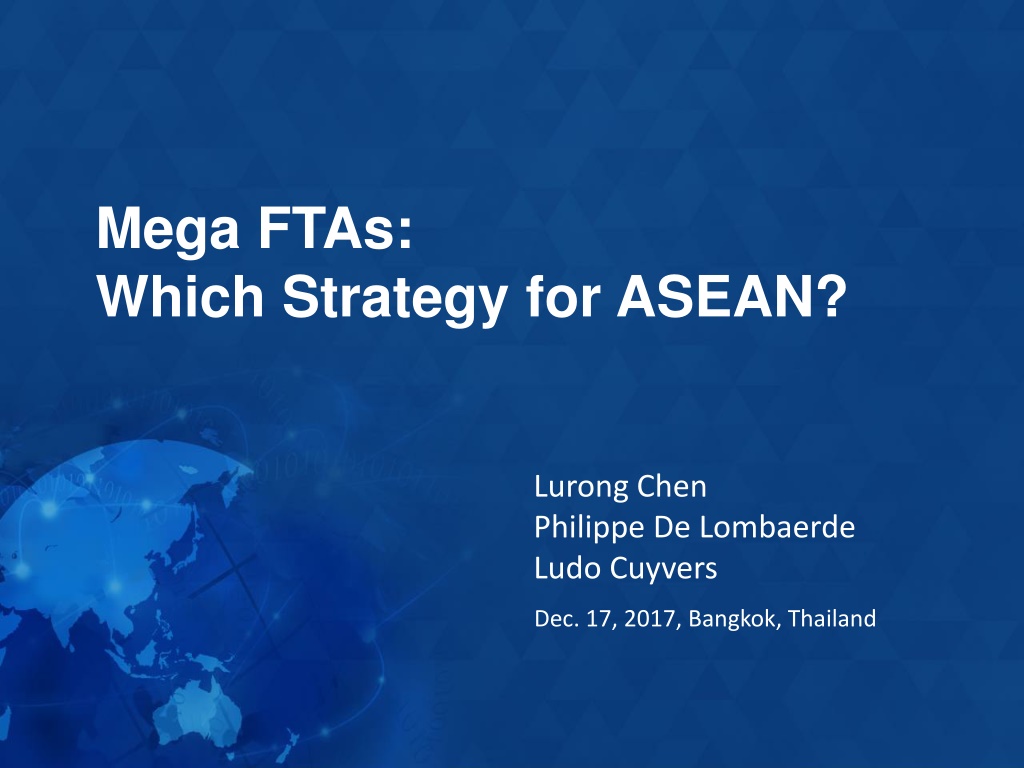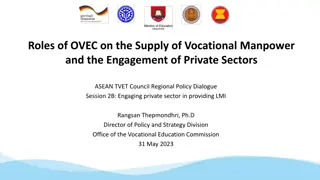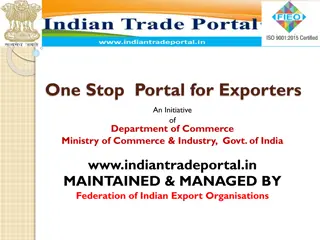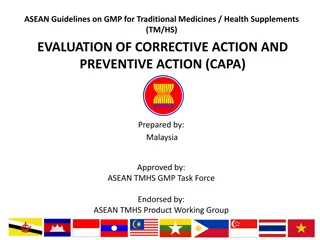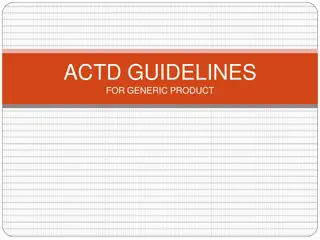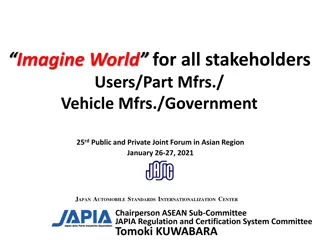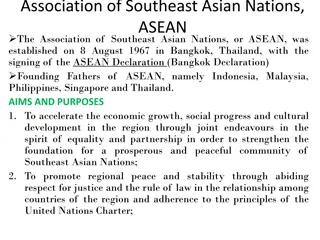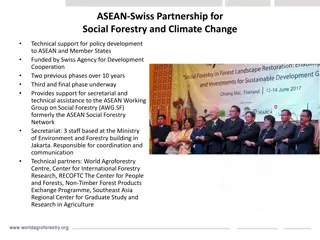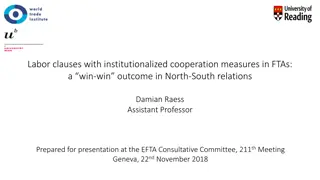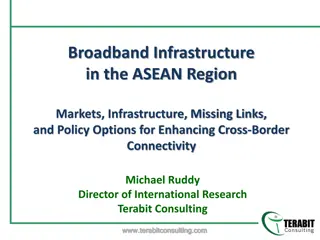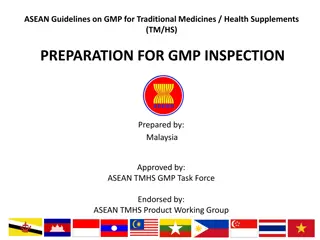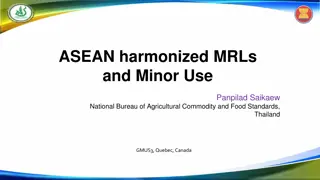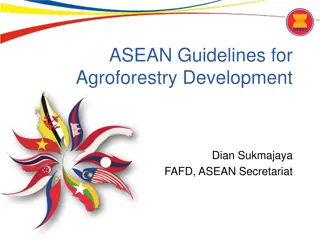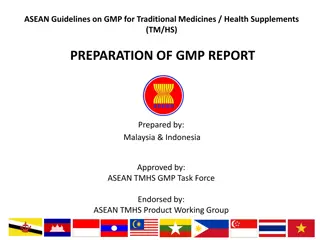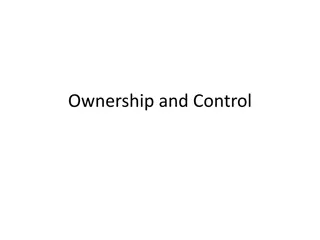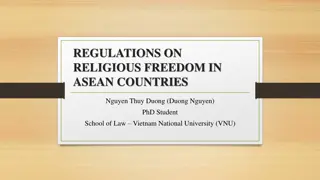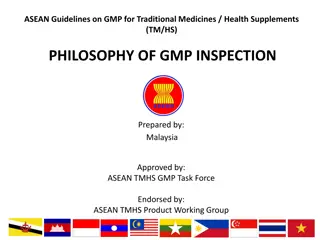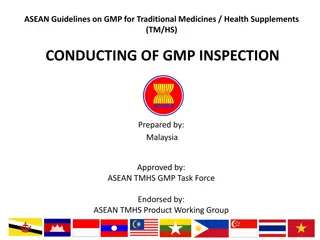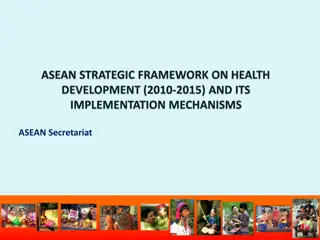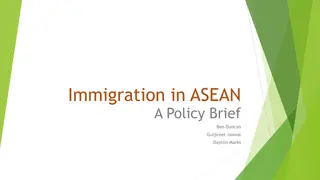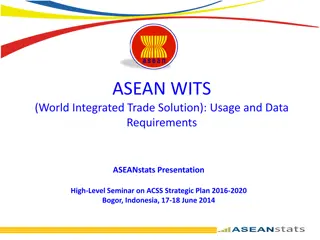Strategy Analysis for ASEAN Mega FTAs
Delve into the complexities of ASEAN's engagement in Mega FTAs, focusing on market gravitation comparison and trade rules with a strategic approach to navigate the evolving global economic landscape. Explore the dynamics of new market access and rules for 21st-century trade within the ASEAN region and beyond.
Download Presentation

Please find below an Image/Link to download the presentation.
The content on the website is provided AS IS for your information and personal use only. It may not be sold, licensed, or shared on other websites without obtaining consent from the author.If you encounter any issues during the download, it is possible that the publisher has removed the file from their server.
You are allowed to download the files provided on this website for personal or commercial use, subject to the condition that they are used lawfully. All files are the property of their respective owners.
The content on the website is provided AS IS for your information and personal use only. It may not be sold, licensed, or shared on other websites without obtaining consent from the author.
E N D
Presentation Transcript
Mega FTAs: Which Strategy for ASEAN? Lurong Chen Philippe De Lombaerde Ludo Cuyvers Dec. 17, 2017, Bangkok, Thailand
Outline Introduction Mega FTAs FTAs of ASEAN MS with the rest of the Asia- Pacific Region Comparing market gravitation: TPP, CPTPP, and RCEP New trade rules in the TPP agreement Discussing ASEAN s strategy
Introduction Mega FTAs 21st century trade, characterized by the expansion of GVCs. The emergence of Factory Asia mirrors the expansion of international trade of intermediate goods and services, particularly in a regional context. Mega FTAs emerged to fill the gap in global governance and reshape the world economic order.
Two considerations New Market access Countries exporters are hoping for better access to foreign markets, particularly those that are fast growing or have big potential to grow. Rules for the 21st century trade With the intention to cover sectors not addressed in world trade talks under the auspices of the WTO.
FTAs of ASEAN MS with the rest of the Asia-Pacific Region Export and import shares of ASEAN (2004-2016) Shares of inward FDI in ASEAN (2010-2016) FTAs of ASEAN countries Weighted average MFN tariff (%) applied and faced in major Asia-Pacific trading partners (2015) Binding AVEs of NTMs by importing Asia-Pacific country and NTM type (simple averages) Provisions on services in FTAs of ASEAN countries (Number of provisions) Provisions on investment in FTAs of ASEAN countries (Number of provisions)
Table 1: Export and import shares of ASEAN (2004-2016) Structure of ASEAN MS total trade in goods Exports 2004 Imports 2004 Exports 2010 Imports 2010 Exports 2016 Imports 2016 Extra-ASEAN 75,1% 76,2% 74,8% 75,0% 76,0% 77,9% Asia-Pacific 52,6% 50,0% 55,3% 51,9% 56,1% 57,3% China (incl. Hong Kong) 12,6% 11,3% 17,7% 14,6% 19,4% 22,0% USA 14,1% 11,1% 9,5% 8,5% 11,4% 7,4% South Korea 3,5% 4,1% 4,3% 6,0% 4,0% 7,2% Japan 11,8% 15,1% 9,8% 12,2% 8,3% 9,7% Australia 2,8% 1,8% 3,6% 2,0% 2,9% 1,8%
Table 2 : Shares of inward FDI in ASEAN (2010-2016) Structure of total inward FDI in ASEAN MS by source country 2010 2015 2016 intra-ASEAN 15,1% 17,9% 25,2% Asia-Pacific 43,6% 51,3% 59,3% China (incl. Hong Kong) 6,0% 8,8% 20,3% USA 12,6% 19,4% 12,5% South Korea 4,0% 4,7% 5,9% Japan 12,0% 12,2% 11,8% Australia 3,7% 1,6% 3,5%
Table 3: FTA involvement of ASEAN countries FTAs (incl. negotations) (1) Of which FTAs under negotiation (2) Bilateral FTAs in Asia (4) Bilateral FTAs in Oceania (5) Bilateral FTAs in North & South America (6) ASEAN FTAs (3) Brunei 11 1 6 1 Cambodia 8 1 6 Indonesia 17 6 6 4 2 Laos 10 1 6 1 Malaysia 22 4 6 3 2 2 Myanmar 10 2 6 1 1 Philippines 11 2 6 1 Singapore 33 7 6 7 2 6 Thailand 23 8 6 3 2 2 Vietnam 16 3 6 2 1 Total bilateral 23 6 14
Table 4: Weighted average MFN tariff (%) applied and faced in major Asia-Pacific trading partners (2015) Weighted average MFN tariff applied of which agriculture Faced in China Faced in Malaysia Faced in Japan Faced in the USA Brunei 1,2 0,1 0 4,9a Cambodia 9,3 12,1 11,1 16,0 16,3 34,4a Indonesia 6,8 7,8 4,2 1,3 7,6 13,0a Laos 8,5 11,2 1,1 15,6a Malaysia 4,3 11,7 1,8 0 0,5 0,7 Myanmar 5,6 8,6 5,6 10,3 Philippines 5,3 11,3 1,1 0,9 3,9 Singapore 0,5 11,9 2,9 1,3 2 40,0a Thailand 6,6 36,3 4,3 1,3 2,1 Vietnam 5,7 8,3 4,1 3,7 7,9
Table 5 : AVEs of binding NTMs by importing Asia-Pacific country and NTM type (simple averages) Sanitary and phytosanitary measures (SPS) Technical barriers to trade (TBT) Quantitative restrictions (QRS) Other counterting measures (OCA) Anti-dumping measures (ADP) Tariff Australia Canada Chile -0,8 0,1 3 1 24,1 17,8 -7,8 -24,2 43,2 1,5 -27,2 2,1 5,1 1 -1,9 -0,5 China 15,3 7,5 14,5 77,5 6,9 Indonesia 0,6 18,5 -10,5 10,6 5,1 Japan -0,9 4,9 0,8 3,8 Korea -4,1 0 -1,3 1,1 -0,1 7,1 Malaysia 1,7 5,9 -2,2 66,9 5,7 New Zealand 3,7 5,6 14,4 -100 3,8 Philippines 7,8 2 58,2 1,3 Singapore 4,6 8 16,1 0,4 Thailand 1,5 -0,4 0,3 -37,5 8,7 USA -0,7 -3,3 2,2 12,5 3,1 Vietnam -6 9,1 5 Average World Average East Asia & Pacific 8,2 10,8 2,5 19,4 5 -2 5,1 -0,1 1,2 0,1
Table 6 : Services provisions in FTAs of ASEAN countries (Number of provisions) Cross border trade (modes 1 and 2) Commercial presence Mobility of persons Mutual recognition FTAs considered Market access Brunei 4 5 2 1 2 8 Cambodia 3 4 1 1 2 7 Indonesia 4 5 2 2 3 13 Laos 3 4 1 1 2 8 Malaysia 6 7 5 5 6 14 Myanmar 3 4 1 1 2 9 Philippines 3 5 2 2 3 8 Singapore 11 12 8 9 10 22 Thailand 6 7 4 3 4 18 Vietnam 5 6 3 3 4 10
Table 7 : Investment provisions in FTAs of ASEAN countries (Number of provisions) Scope & coverage Expropriation & compensation FTAs considered Safeguards Transfers Brunei 4 1 3 1 8 Cambodia 3 2 1 7 Indonesia 4 1 3 2 13 Laos 3 2 1 8 Malaysia 7 2 6 4 14 Myanmar 3 2 1 9 Philippines 4 1 3 2 8 Singapore 11 3 10 9 22 Thailand 6 1 5 4 18 Vietnam 5 3 2 10
Comparing market gravitation - method ????=???? ??? 1 ???? ? ????? ??? ??? ? ????? ? ???? ????= ? 1 HMAB: market gravitatin of nation B from nation A s perspective EXAB and IMAB : bilateral trade flows from A to B, measured by exports and imports respectively EXA : A s total exports to the world IMB : B s total imports from the world. : degree of market integration of B
Comparing market gravitation - results TPP RCEP TPP-12 CPTPP = 0.95 = 0.9 = 0.8 Brunei 0.54 0.53 0.86 0.82 0.73 Cambodia 0.44 0.19 0.22 0.21 0.19 Indonesia 0.41 0.30 0.56 0.53 0.47 Lao PDR 0.21 0.20 0.86 0.82 0.73 Malaysia 0.39 0.30 0.57 0.54 0.48 Myanmar 0.13 0.12 0.86 0.81 0.72 Philippines 0.47 0.32 0.49 0.47 0.41 Singapore 0.29 0.23 0.54 0.51 0.46 Thailand 0.40 0.29 0.51 0.49 0.43 Viet Nam 0.37 0.17 0.37 0.35 0.31 ASEAN 0.33 0.23 0.45 0.43 0.38
New trade rules in the TPP agreement Areas covered FTA industrial goods; FTA agricultural goods; Customs administration; Export taxes; Sanitary and phytosanitary (SPS); measures; Technical barriers to trade (TBT); State trading enterprises (STE); Antidumping (AD); Countervailing measures (CVM); State aid; Public procurement; Trade-related investment measures (TRIMs); Trade in services agreement (GATS); Trade-related intellectual property rights (TRIPs). WTO Plus Anti-corruption; Competition policy ; Consumer protection; Data protection; Environmental laws; Investment; Movement of capital; Labour market regulations; Intellectual Property Rights (IPR) ; Agriculture; Approximation of legislation; Audio visual; Civil protection; Innovation policies; Cultural cooperation; Economic policy dialogue; Education and training; Energy; Financial assistance; Health; Human rights; Illegal immigration; Illicit drugs; Industrial cooperation; Information society; Mining; Money laundering; Nuclear safety; Political dialogue; Public administration; Regional cooperation; Research and technology; Small and medium enterprise; Social matters; Statistics Taxation; Terrorism Visa and asylum. WTO Extra
Discussing ASEANs strategy continuously promote trade liberalization and regional community building reduction of non-tariff measures (NTM) trade liberalization in the agricultural sector trade in services short run: conclude RCEP to secure export markets long run: consider new issues and aim for high quality provisions
